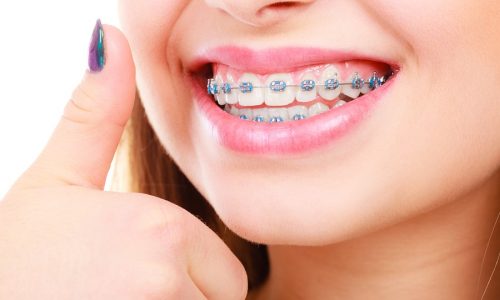How Do Braces Work?
Braces are an orthodontic appliance used to fix misaligned teeth, overcrowding, excess space between teeth, or a misaligned jaw – a condition known as malocclusion. Braces are the treatment option most often used for children and teenagers, but more adults have been open to the idea of getting braces in recent years.
Braces are the most widely known appliance for straightening teeth, and there are many various kinds. Different factors affect what kind of braces we will recommend for your treatment.

Often, having an overbite, underbite, or crossbite in addition to crooked teeth will determine which type of braces you need. Regardless, each set of braces is custom-made and individually fitted to each patient’s mouth.
Traditional braces are made of metal brackets placed on the front of each tooth using adhesive. An archwire puts pressure on your teeth and jawline, and rubber bands connect this archwire to the brackets. During visits to our office, the archwire is adjusted, and teeth move slowly into their correct alignment as the pressure is applied. Rubber bands in the braces are switched out at appointments with our office, which tighten to apply increased pressure to the teeth.
How Do Braces Move Teeth?
Braces work by moving teeth with constant applied pressure for long periods of time. As you wear your braces longer, your jaw adjusts to this pressure, conforming and adapting to the appliance. Many people are under the misconception that our teeth are directly connected to our jawbones, making it difficult or impossible to move teeth into a different position. However, underneath the gums, there is a membrane that is surrounded by bones, which roots our teeth to our jaw. This membrane helps position the teeth as they grow into the mouth, and will respond to pressure being put on your teeth by braces.
While the process of placing braces doesn’t hurt intrinsically, you may experience soreness following your initial placement. Additionally, after follow-up appointments with our office during which the archwire is adjusted, your teeth, jaw, and membrane may feel some temporary soreness as they adjust to the added pressure.
Bracket Adhesion
When getting your braces on, we use a glue to make sure the brackets will stay on your teeth throughout wear. Your teeth will initially be cleaned and dried in order to make sure the adhesive will stick. Ceramic, plastic, or stainless steel brackets will then be placed with adhesive onto your teeth. The initial placement of brackets may be uncomfortable, but it is not painful. Then, these brackets make sure pressure is applied evenly across your teeth. They are connected by wires made from stainless steel, nickel titanium, or copper titanium called archwires.
Bands
Sometimes, rubber bands or elastic o-rings, sometimes referred to as ligatures, are placed around each bracket once they are placed on your teeth. The purpose of these bands is to add extra pressure to your jaw in order to work towards correcting any jaw misalignment.
Spacers
Sometimes, we will prescribe spacers to go along with your braces. Spacers are made from rubber bands or metal rings, and are placed between molars, meant to push your jaw forward by adding space in the back of your mouth. This process helps to correct any malocclusion, or jaw misalignment. Spacers can also help make room for braces when the back of your mouth does not have enough space to properly fit them. They are only used for about one or two weeks at a time, and not all patients will need them as a part of their treatment.
Archwires
Archwires are the main wires that connect the brackets placed on your teeth. Archwires apply the primary pressure to push your teeth into correct alignment. During visits to our office, we will adjust the archwire of your braces to change pressure as your teeth move.
Types of Braces
In addition to metal and ceramic braces, other types of braces are available as well, including lingual braces and clear aligners. Lingual braces are placed on the inner side of your teeth, rather than the outside, like traditional braces. This makes them less noticeable. Clear aligners are removable and are virtually invisible. They can be removed while eating or brushing your teeth, making oral hygiene during treatment easier.
Braces Mill Creek WA
At Sullivan Bastian Orthodontics, we want you to feel comfortable making the decision to work towards your optimal oral health. If you have any questions, feel free to call our office at (425) 385-2641.

